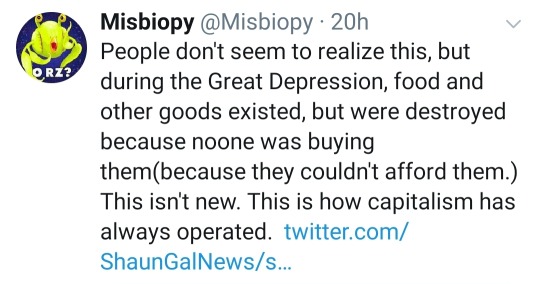science, news, economics, humor, music; "son of the American Revolution;" youngest ever ordained Deacon at my church; omnist fae oracle; funky solarpunk; Age: 30-something, he/him; manic pixie dreambeast; #BLM #MMIW #MMIP
Don't wanna be here? Send us removal request.
Text
the weed dispensaries should ask if you would like to round up your purchase to donate to PBS. and if you say yes you get to scan a QR code that gives you 30-day free access to the full run of antiques roadshow. this is how drugs can win the war on drugs again.
45K notes
·
View notes
Text

Giant, free-floating planets may form their own planetary systems
New research from the University of St Andrews has found that giant free floating planets have the potential to form their own miniature planetary systems without the need for a star.
In findings published on the arXiv preprint server, researchers using observations from the James Webb Space Telescope (JWST) investigated young isolated objects with masses of 5–10 times the mass of Jupiter. These objects are comparable to giant planets in their properties, but in contrast to giant planets, they are not in orbit around a star; instead they are free-floating in space.
Free floating planets are challenging to observe, as they are very dim and radiate mostly in the infrared. And yet, they hold the key to important questions in astrophysics. Current research suggests that these are the lowest mass objects formed like stars from the collapse of giant gas clouds.
In contrast to stars, they do not accumulate enough mass to start any fusion reactions in their cores. In theory, it is also possible that some of them form in a way comparable to planets, in orbit around a star, and later ejected from their planetary nurseries.
Researchers from the School of Physics and Astronomy along with co-authors from the U.S., Italy, Ireland, England and Portugal, observed eight of these objects, all very young, to learn more about their infancy. They used two instruments on board the James Webb Space Telescope, the largest space telescope ever built, equipped with extremely sensitive infrared instruments. Detailed spectroscopic observations for these objects, with unprecedented spectral coverage and sensitivity, from August to October 2024, were analyzed.
This new work characterizes these objects in depth, and confirms that they have masses around the same size as Jupiter. Six of them have excess emissions in the infrared caused by warm dust in their immediate vicinity. This is the characteristic sign of disks, flattened structures which are the birthplaces of planets.
Observations also show emission from silicate grains in the disks, with clear signs of dust growth and crystallization—the typical first steps in the formation of rocky planets. Silicate emission has been found for stars and brown dwarfs before, but this is the first detection in planetary-mass objects. This work builds on a previously published paper from the University of St Andrews showing that disks around free-floating planetary mass objects can last several million years, plenty of time to form planets.
Dr. Aleks Scholz, the Principal Investigator of the project, said, "Taken together, these studies show that objects with masses comparable to those of giant planets have the potential to form their own miniature planetary systems. Those systems could be like the solar system, just scaled down by a factor of 100 or more in mass and size. Whether or not such systems actually exist remains to be shown."
Lead author Dr. Belinda Damian from the University of St Andrews, said, "These discoveries show that the building blocks for forming planets can be found even around objects that are barely larger than Jupiter and drifting alone in space. This means that the formation of planetary systems is not exclusive to stars but might also work around lonely starless worlds."
IMAGE: AI generated image of a young free floating planetary-mass object surrounded by a dusty disk. Credit: University of St Andrews
9 notes
·
View notes
Text
the reason they called the middle ages "midieval" is because while they couldn't really spell at the time, they could still sense things were bad, but that the future would be signicantly more evil
2 notes
·
View notes
Text
Reminder that Sudan-Funds shares multiple campaigns that are in need as Sudan faces one of the most frightening man-made starvations in history
2K notes
·
View notes
Text

savvy
a word meaning "shrewdness and practical knowledge"
I would bet this is a cognate from the Spanish word, saber, to know...
not pronounced like a sword you rattle, the Spanish pronounciation rhymes with the random phrase "not hair," or "au pair" like the French word for a live-in nanny/housekeeper. Saber is also pronounced with a "v" sound in Spanish not a "b" sound
this verb, saber, is infinitive, so if you wanna say like "ya know" as a phrase of speech, like people often do (y'know?) folks say "sabe?"
That's how you conjugate saber politely, or almost pedantically if it's a friend, otherwise you'd say "¿sabes?" to a friend casually.
And sabe is pronounced almost identically to "savvy" aside from the Latinized or Anglicized a-sound, and it's used exactly like Jack Sparrow uses it, savvy?! 🫠😨😲😵
3 notes
·
View notes
Text




11K notes
·
View notes
Text
fkn TBI roulette wheel

1K notes
·
View notes
Text


This is capitalism's vast irrationality and inhumanity in action. Markets and The Economy™ matter more to capitalism than the concrete distribution of resources according to tangible human need.
Resources exist in abundance -- give them to people. Housing sits empty -- give it to people. The rules of the feast table should apply to our economic system -- no one gets seconds until everyone has gotten a plate.
We stand at a crossroads in these chaotic times: socialism or barbarism! The ruling class repeatedly chooses the latter. We need to organize and choose the former!
112K notes
·
View notes
Text
Trump is the worst liar
Or
he has full-on dementia
Which is it?

28 notes
·
View notes
Text
12 notes
·
View notes




